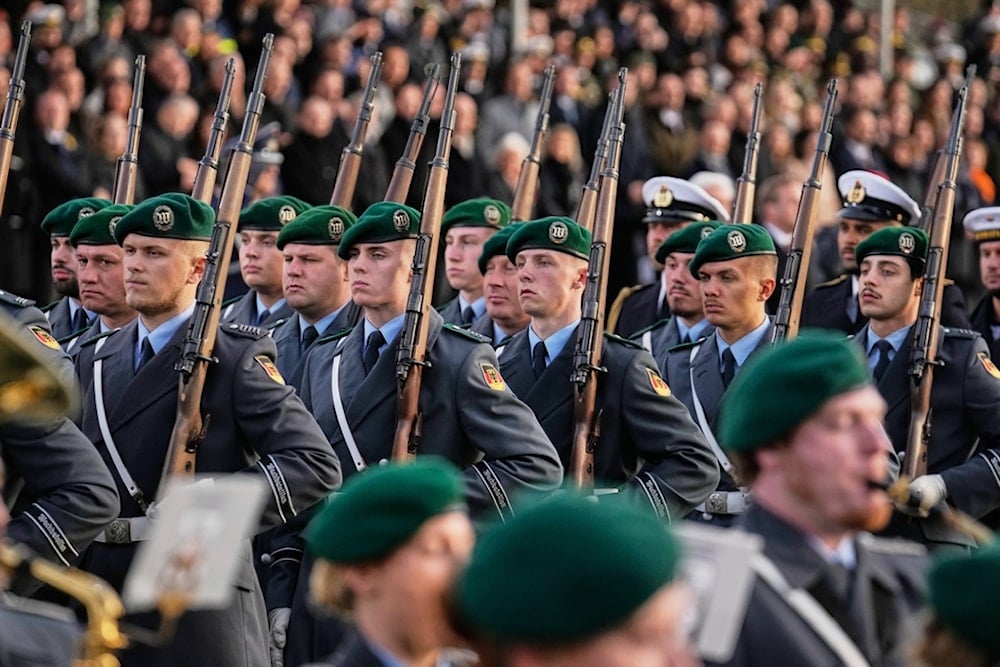Germany to deploy six kamikaze-drone units by 2029
Germany’s rapid expansion of drone, deep-strike, and precision-warfare units forms part of a sweeping post-2022 military rearmament drive aimed at rebuilding deterrence.
-

Soldiers take part in the ceremonial pledge as a central event to mark the 70th anniversary of the Bundeswehr German army) in Berlin, Germany, Wednesday, Nov.12, 2025 (AP Photo/Ebrahim Noroozi)
Germany is moving to rapidly expand its drone-warfare capabilities, with the armed forces preparing multiple new units built around loitering munitions and long-range precision weapons. According to reporting from the German news agency DPA, the Bundeswehr intends to field six formations equipped with kamikaze-style drones by 2029, a timeline that reflects Berlin's push to modernize its strike options and its wider shift toward rebuilding a force capable of high-intensity warfare.
This acceleration forms part of Germany's post-2022 Zeitenwende, a strategic turning point triggered by the war in Ukraine, which exposed the limits of a military that had been downsized for decades after the Cold War. Berlin has since created a €100 billion special defence fund, pledged to meet and exceed NATO spending benchmarks, and begun one of Europe's largest procurement overhauls. Defence budgets are projected to rise sharply through 2029, with plans to acquire new air-defence platforms, long-range missiles, tanks, and unmanned systems. The government is also debating a revised form of national service to address shortages in personnel.
Deterrence Rebuilt
Army commander Christian Freuding, who previously oversaw Germany's military support to Ukraine, confirmed that early trials are in progress. "We've begun testing," he said, noting that the first medium-range battery is expected to reach full operational capability in 2027. His remarks reflect growing urgency within defence leadership, who have repeatedly warned that Germany must rebuild credible deterrence capabilities capable of responding to a potential European security crisis.
By the end of the decade, the Bundeswehr also expects to stand up a unit built around Ground Based Deep Precision Strike systems, long-range weapons designed to hit high-value targets from afar. This marks a departure from Germany's post-1990 posture, where expeditionary peacekeeping took precedence over heavy conventional strike options. Alongside this, German forces are evaluating loitering munitions, a class of drones that remain airborne while scanning for targets before diving into them, a capability that has become central to modern conflicts in Ukraine and the South Caucasus.
German Rearmament
Recent steps underscore how extensive the modernization drive has become. Berlin has committed to raising defence spending to roughly 3.5 percent of GDP by 2029, is restructuring procurement agencies to speed up acquisitions, and is permanently stationing German troops abroad for the first time since World War II as part of its new deterrence posture. The Bundeswehr is also expanding drone-defence units within Germany itself, reflecting concerns about both state and non-state actors' use of unmanned systems.
Industrial preparations mirror the military shift. In August, Handelsblatt reported that Stark Defense will partner with an MBDA subsidiary to manufacture the drones. Thousands of units are slated for delivery beginning in 2027, marking one of Germany's greatest drone-production efforts to date and signaling an attempt to reduce reliance on foreign suppliers while cultivating a domestic drone-warfare industry suited to long-term rearmament.
Europe’s unease as Germany’s costly rearmament meets manpower limits
The push to field large numbers of loitering munitions and long-range strike units runs straight into three hard constraints: money, bureaucracy, and people. Financially, it means hundreds of billions more over the decade.
Berlin has pledged to push core defence spending toward ~3.5% of GDP, but ministers and analysts warn the target and funding timeline are uncertain and may fall short. Procurement and industrial bottlenecks compound the problem: slow, fragmented acquisition processes and strained European supply chains risk long delays and cost overruns that blunt the effect of new budgets.
The Bundeswehr’s chronic recruitment and retention shortfalls also make it hard to staff and sustain new formations even if equipment arrives on time. Politically, many European partners quietly welcome Germany doing more for collective defence but remain uneasy about the pace, industrial competition, and the wider implications of rapid rearmament.
Read more: Germany placed as NATO’s main bridgehead in potential war with Russia

 4 Min Read
4 Min Read








